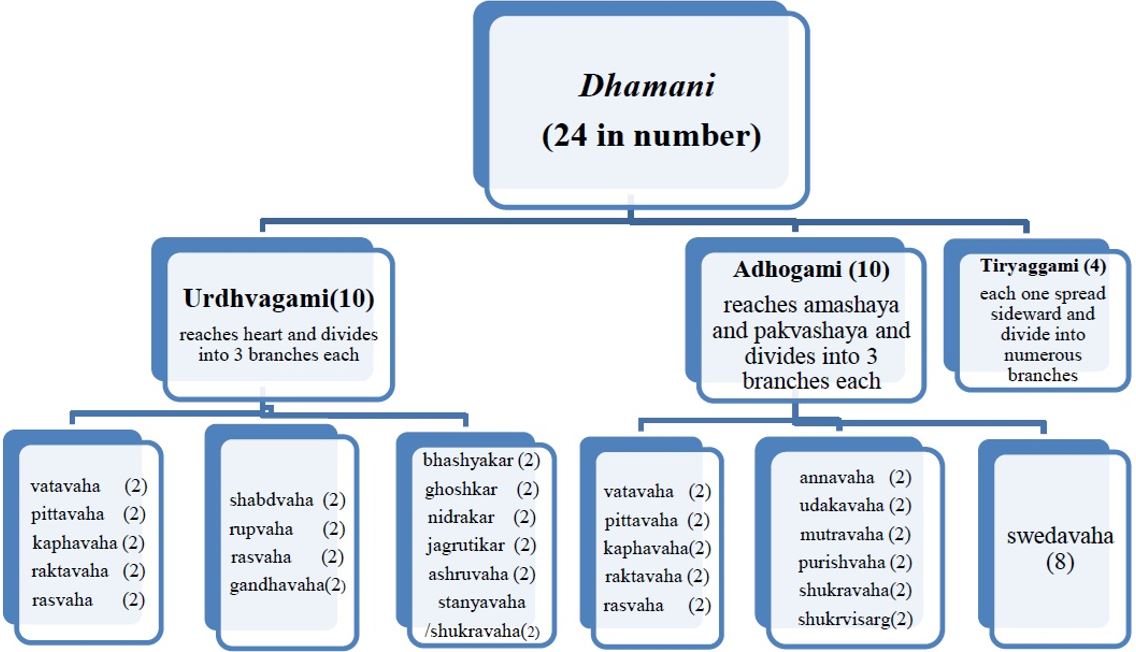Conceptual study of Dhamani Sharir in Modern Perspective: A Review Study
DOI:
https://doi.org/10.21760/jaims.10.6.44Keywords:
Dhamani, Artery, Sira, Srotas, Nerve, HeartAbstract
Ayurveda is a traditional Indian healing system that has been practiced for more than 5000 years. One of its most important anatomical terms, Dhamani, has been the subject of much debate among scholars. According to classical texts by Acharya Sushruta, Charaka and Vaghbhata, Dhamani are thick-walled ducts that transport Rasa (plasma/lymph chyle) and Rakta (blood). Although they are sometimes used interchangeably with Sira (vein) and Srotas (capillary), Acharya Sushruta distinguishes them as arteries because of their pulsatile nature. Ayurveda incorporates modern anatomical structures—veins, capillaries, lymphatics, and nerves—within the terms Sira, Dhamani, and Srotas. The cardiovascular system, which is essential for maintaining life, is represented by Hridaya (heart), Sira, and Dhamani with the heart serving as the central pumping organ. According to Sushruta, ten Dhamanis extend upward, ten downward, and four laterally from the Nabhi (navel), while Acharya Charaka states they originate from the heart. The Urdhvagami Dhamanis (upward) regulate sensory and vocal functions, Adhogami Dhamanis (downward) facilitate excretion, and Tiryaggami Dhamanis (lateral) likely correspond to peripheral blood vessels. The circulatory system consists primarily of arteries, with the heart and veins making up the other major parts. Arteries are tube-like structures that carry fluid to and from all of the body's organs. For the circulatory system, this means blood, and for the lymphatic system, lymph. Arteries primarily regulate how oxygen, nutrients, and hormones are transported throughout our body. Once oxygen is loaded onto the Fe 2+ atom in the middle of hemoglobin, arteries can release new oxygen into the body. Hemoglobin binds to oxygen, which is then transported via the arteries to oxygen-deficient regions. It is then discharged to particular regions via large surface areas called capillaries due to a change in affinity for the oxygen.
Downloads
References
Acharya JT, Chakrapanidatta. Ayurveda Dipika, Charaka Samhita. 7th ed. Varanasi: Chaukambha Orientalis; 2013. Sutrasthana, Chapter 30. p. 185.
Acharya JT, Chakrapanidatta. Ayurveda Dipika, Charaka Samhita. 7th ed. Varanasi: Chaukambha Orientalis; 2013. Sutrasthana, Chapter 30. p. 185.
Acharya JT, Chakrapanidatta. Ayurveda Dipika, Charaka Samhita. 7th ed. Varanasi: Chaukambha Orientalis; 2013. Sutrasthana, Chapter 30. p. 185.
Kunte AM, Vagbhatta. Ashtanga Hridaya. Varanasi: Chaukambha Publications; 2014. Sharira Sthana, Chapter 34. p. 392.
Shastri PP. Adhamalla Deepika, Sharangadhara Samhita. Varanasi: Chaukambha Orientalis; 2012. Chapter 3. p. 28.
Murthy KRS. Illustrated Sushruta Samhita. Reprint ed. Varanasi: Chaukhambha Orientalia; 2017. Sutra Sthana, Chapter 14. Vol. 1, Sec. 1. p. 86.
Sharma PV. Charaka Samhita. Varanasi: Chaukhambha Orientalia; 2014. Siddhi Sthana, Chapter 9. Vol. 2. p. 644.
Murthy KRS. Charaka Samhita. Reprint ed. Varanasi: Chaukhambha Orientalia; 2017. Sutra Sthana, Chapter 30. Vol. 1, Sec. 1. p. 512.
Agnivesha. Charaka Samhita, Sutra Sthana, Chapter 30. In: Sharma RK, Dash B, editors. Charaka Samhita (English translation and critical exposition based on Chakrapani Dutt’s Ayurveda Dipika). 7th ed. Varanasi: Chowkhambha Sanskrit Series; 2013.
Vagbhata. Astanga Samgraha, Sharira Sthana, Chapter 6. In: Murthy KRS, editor. Astanga Samgraha (English translation). Reprint ed. Vol. II. Varanasi: Chowkhambha Orientalia; 2009. p. 78–79.
Murthy KRS. Illustrated Sushruta Samhita. Reprint ed. Varanasi: Chaukhambha Orientalia; 2017. Sharira Sthana, Chapter 9. Vol. 1, Sec. 3. p. 142.
Murthy KRS. Illustrated Sushruta Samhita. Reprint ed. Varanasi: Chaukhambha Orientalia; 2017. Sharira Sthana, Chapter 9. Vol. 1, Sec. 3. p. 143.
Murthy KRS. Illustrated Sushruta Samhita. Reprint ed. Varanasi: Chaukhambha Orientalia; 2017. Sharira Sthana, Chapter 9. Vol. 1, Sec. 3. p. 144.















